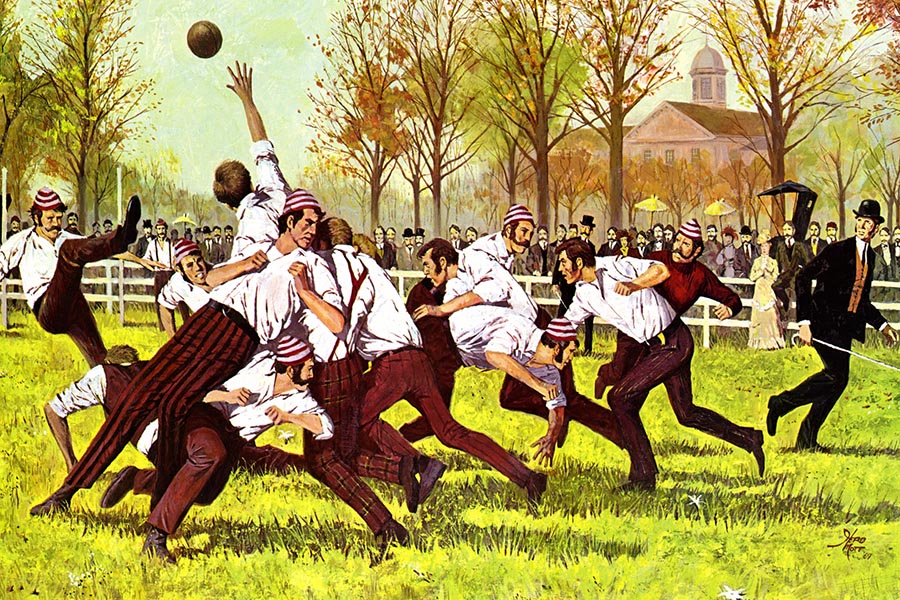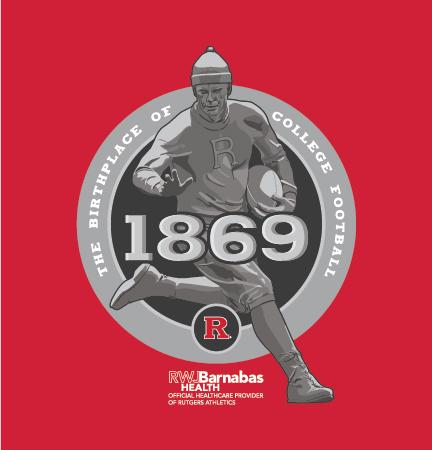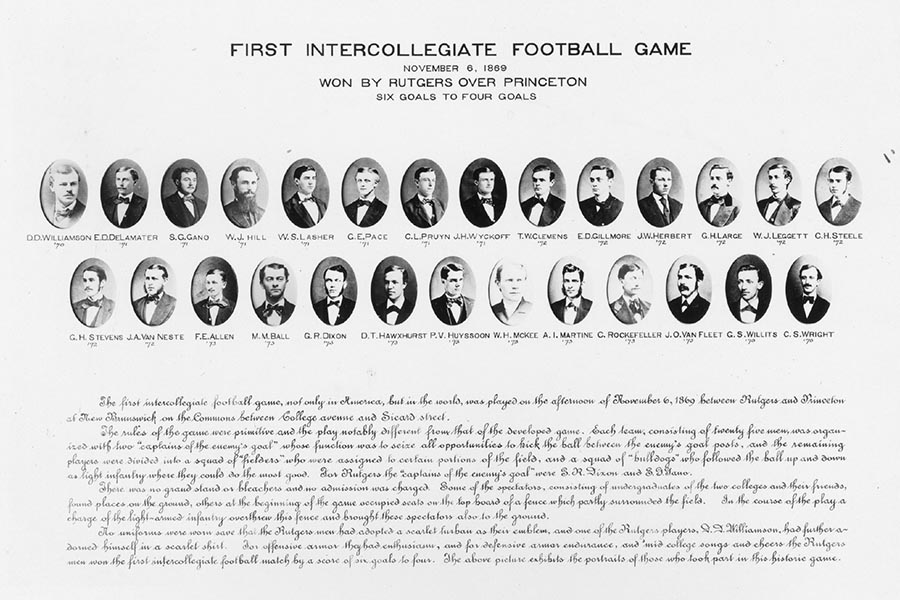The Birthplace of College Football
In the first collegiate football game 150 years ago, Rutgers beat Princeton
The desire for revenge can be long-lasting. It’s as good an explanation as any to account for why Rutgers and Princeton came together 150 years ago to play the first collegiate football game, on November 6, 1869.
Three years earlier, the Princeton baseball team had humiliated Rutgers 40–2. In the intervening time, Rutgers students, under the leadership of the Reverend C.D. Hartranft, the pastor of a Dutch Reformed Church in New Brunswick, had put together a team to play football. Turns out, Princeton had, too.

An illustration of the first football game held on Nov. 6, 1869 (Photo: Special Collections and University Archives)
Rutgers team members decided the time was right to challenge Princeton, also one of the original colonial colleges, to a game. Rutgers chose as their captain William J. Leggett, who wrote a letter laying down the challenge: a series of three football games. Princeton, represented by its captain, William S. Gummere, wasted no time in responding: game on!

The two captains couldn’t have possibly imagined that their two teams were about to initiate a sports phenomenon that would become an obsession on college campuses nationwide and pave the way to big-time multibillion-dollar collegiate football.
The Princeton team, arriving by train in New Brunswick, got a warm welcome at the station from members of the Rutgers team, who entertained their visitors before the game by showing them points of interest in the city (a billiards hall was particularly appreciated). Meanwhile, the two captains hashed out rules for the football game, one that, in the early versions of the sport as practiced by the two schools, more resembled today’s game of soccer. It was agreed that each team would field 25 players who would be allowed to bat the ball with their fists or hands, in addition to their feet. The playing surface was 360 by 225 feet, with goals on each end that were 24 feet wide. Players were not allowed to hold or trip opponents. The first team to score six “games,” or points, would be the winner.
With perhaps 100 people convening to watch the spectacle, players on each team—“bull dogs” or “fielders” or “captains of the opponent’s goal”—shed their overcoats, vests, and hats and took their positions on the field, located on a plot of land behind the College Avenue Gymnasium at Rutgers University–New Brunswick. With a sartorial flourish, the Rutgers players took the field donning scarlet kerchiefs and turbans fashioned from scarves; the bigger, taller players from Princeton, yet to establish orange and black as school colors, wore a combination of street clothes and a rough estimation of athletic wear. There was no such thing as protective gear for either team.

The roster of the first football team (Photo: Special Collections and University Archives)
Soon after the three o’clock kickoff on a chilly November day, mayhem ensued as the wily Rutgers team had to rely on finesse and guile to counter their more aggressive opponents, who were employing an early version of smashmouth football. The Targum described the action as “headlong running, wild shouting, and frantic kicking.” Rutgers registered the first point of college football when George Dixon and Stephen Gano teamed up to score the first point by booting the ball into the Princeton goal. Princeton responded. Rutgers went up 4–2. Princeton tied it again. With Leggett admonishing his team to “keep your kicks short and low,” Rutgers kicked for two more points and won the game 6–4. The first collegiate football game was in the books. The two teams celebrated together afterward over a “fine supper” and singing, with Rutgers serving as gracious host and Princeton gallant in defeat as they boarded the train “thirsting to beat us next time, if they can,” according to the Targum.
A week later, the teams met again, this time in Princeton, playing in a cow pasture now doubling as a playing field. Princeton beat Rutgers convincingly, winning 8–0 and taking full advantage of its rowdy sideline rooters and home team rule stipulations. Following the game, the two teams once again broke bread over a good meal. Echoing the sentiment of the team, the Targum reporter wrote: “If we must be beaten, we are glad to have such conquerors.”
The third game, the rubber match, between Rutgers and Princeton never took place. Because they had outscored Rutgers over the two games by a score of 12–6, Princeton, under a cloud of dispute, was declared national football champion for 1869, even though both teams had records of 1-1. The beginnings of a football rivalry, which resumed the following year and would last until 1980, had been born.